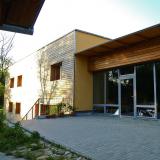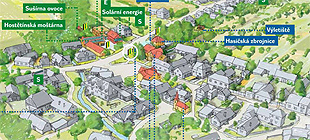
Passive house
The seminar building of Centre Veronica Hostětín is the first public passive house in the Czech Republic
It uses modern technologies together with traditional materials, saves energy, and utilizes rain water. Most of the interior equipment is environmentally friendly too, and it gained the "Environmentally Friendly Service" ecolabel, certificated by the Czech Ministry of Environment.
The idea started with a derelict fram, bought by Veronica in the autumn of 1998 with a vision of a "Centre for ecological model projects for the countryside", a place for sharing practical knowledge. The passive house was inaugurated in October 2006. The project is an example of a unique cooperation of many partners for preparation, financing and realization of the construction.
Construction concept
Passive house with minimum consumption of energy on heating (max. 15 kWh/m2/year).
Used construction methods and technologies
- insulation from mineral wool and straw bales - thickness up to 40 cm
- foundation thermally separated from the ground by a special polystyrene, 20 cm thick
- windows with heat transmission ≤ 0,8 W/(m2.K)
- very good tightness, attested by a special test during the construction (blow door test)
- ventilation with heat recovery from extract air
- heating of water from solar panels
- additional heating from the municipal biomass heating plant
- utilization of rainwater
- green roof
- utilization of environmentally friendly construction materials (plasters from unburnt clay, unburnt bricks, etc.)
The building offers:
- room for 50 people for training and education in the seminar hall
- room for 100 people in the seminar hall for municipal and community meetings
- 25 beds in 10 rooms with 2-4-beds in each
- an office for employees and interns
- workshops and possibilities for practical courses
Architectural design
Georg W. Reinberg, Vienna
Project engineer
Zlámal and Stolek, Brno
Dissemination and education
The seminar building of the Veronica Centre serves for education and training of the public and other target groups (public administration, entrepreneurs, craftsmen, scholars, and students) on sustainable regional development.
The passive house also plays a role of a model of economically and environmentally sound building. It is accessible to expert and general public, and education, information, and knowledge sharing is being organized in the form of open days, topical seminars, and tours, among other things. In 2007, more than 3500 people took part in our model project tours.
It is also possible to get first-hand experience by spending the night in the accommodation part of the Centre Veronica.





 Zobrazit mapu všech projektů »
Zobrazit mapu všech projektů »



